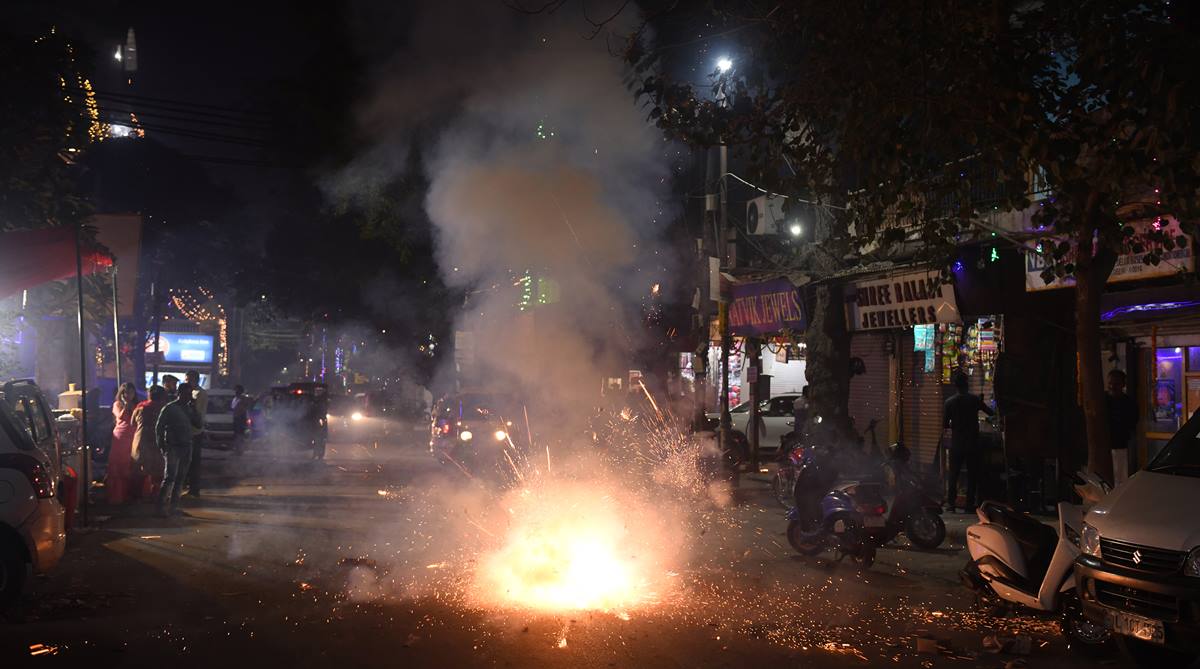Delhi records lowest AQI in 3 years; CAQM lifts GRAP 1 restrictions
According to CAQM, the city registered an AQI of 85, placing it in the satisfactory category— a significant improvement attributed to favorable meteorological conditions.
Some areas record an air quality index of 999; SC cracker ban on Diwali was not effective in Delhi-NCR with people bursting firecrackers well past 10 pm deadline
SNS | New Delhi | November 8, 2018 9:07 am

Firecrackers were burst well past the 10 pm deadline on Diwali in Delhi on Wednesday. (Photo: AFP)
The Diwali evening in Delhi had started off relatively quieter on Wednesday, with not many people bursting crackers till around 8 pm, but the cracker ban put in place by the Supreme Court went up in smoke later as Delhi-NCR continued to burst crackers well past the 10 pm deadline on Wednesday. The Delhi AQI touched the maximum levels on Thursday morning.
A thick haze covered the national capital at night with the air quality deteriorating to “very poor” category.
Advertisement
On Thursday morning, Anand Vihar in Delhi recorded an air quality index (AQI) of 999 (the maximum level the monitors can record), which falls under the “hazardous” category. In central Delhi too, around the Major Dhyan Chand National Stadium, the AQI touched 999 while the US Embassy in Chanakyapuri scored 459.
Advertisement
At 11 pm on Wednesday, the overall Air Quality Index (AQI) was recorded at 302, according to the Central Pollution Control Board (CPCB).
The air quality had started deteriorating from 7 pm, when the AQI was 281, rising to 291 at 8 pm. It further deteriorated to 294 at 9 pm and 296 at 10 pm, as per the CPCB.
The permissible limit for PM2.5 and PM10 is 60 and 80 units by national standards and 25 and 50 units by international standards.
The Supreme Court had limited the time for bursting crackers to two hours, from 8 pm to 10 pm, on Diwali. However, at several place, people started bursting crackers soon after sunset, and continued well after 10 pm.

There was no clarity on how many people were bursting “green crackers”, the only type, apart from the ones not containing the polluting barium salts, allowed by the SC. “Green crackers” have a low light and sound emission and less harmful chemicals.
The police had been asked to ensure banned firecrackers were not sold. The court had also said the station house officer (SHO) of the police station concerned would be held personally liable, and it would amount to committing contempt of the court, in case of any violation.
Delhi Police spokesman Madhur Verma told IANS data was not immediately available at how many places the police took action against those flouting the Supreme Court directive on Diwali day.
The police, however, admitted there were violations, and said they would take serious legal action against those violating the apex court order.
A spike in the air pollution could be seen at many places as the volume of PM2.5 and PM10 stared rising sharply from around 8 pm. Very high pollution levels were recorded in areas such as Anand Vihar, ITO and Jahangirpuri.
All online indicators of the pollution monitoring stations in the city indicated “poor” and “very poor” air quality.
The CPCB data says the 24-hour rolling average of PM2.5 and PM10 were 164 and 294 micrograms per cubic metre, respectively.
The System of Air Quality and Weather Forecasting And Research (SAFAR) has forecast “bad” air quality on Thursday too, adding the pollution levels would peak between 11 am and 3 am.
The situation was similar in Gurgaon, Noida and Ghaziabad, where crackers were burst as usual.
The ultra-fine particulates of PM2.5 and PM10 enter the respiratory system and manage to reach the bloodstream. Prolonged exposure to a “very poor” AQI means people may suffer from respiratory illnesses. A further drop in the air quality will turn the AQI “severe”, which may seriously affect those suffering from heart ailments.
Meanwhile, the Centre and the Delhi government have launched a 10-day “Clean Air Campaign” from November 1 to 10 to monitor and report polluting activities and ensure quick action.
As part of the campaign, 52 teams are visiting different parts of Delhi and the neighbouring towns of Faridabad, Gurugram, Ghaziabad and Noida.
The teams led by sub-divisional magistrates of the respective areas comprise senior officials from the Ministry of Environment, Forest and Climate Change, representatives of CPCB, Municipal Corporation of Delhi and the Delhi Pollution Control Committee.
(With agency inputs)
Advertisement
According to CAQM, the city registered an AQI of 85, placing it in the satisfactory category— a significant improvement attributed to favorable meteorological conditions.
Delhi recorded its lowest Air Quality Index (AQI) of the year on Friday, with an average AQI of 121, according to the daily AQI Bulletin released by the Commission for Air Quality Management (CAQM).
According to the India Meteorological Department (IMD), weather conditions are expected to remain similar over the next three days, with no significant changes in temperature.
Advertisement
